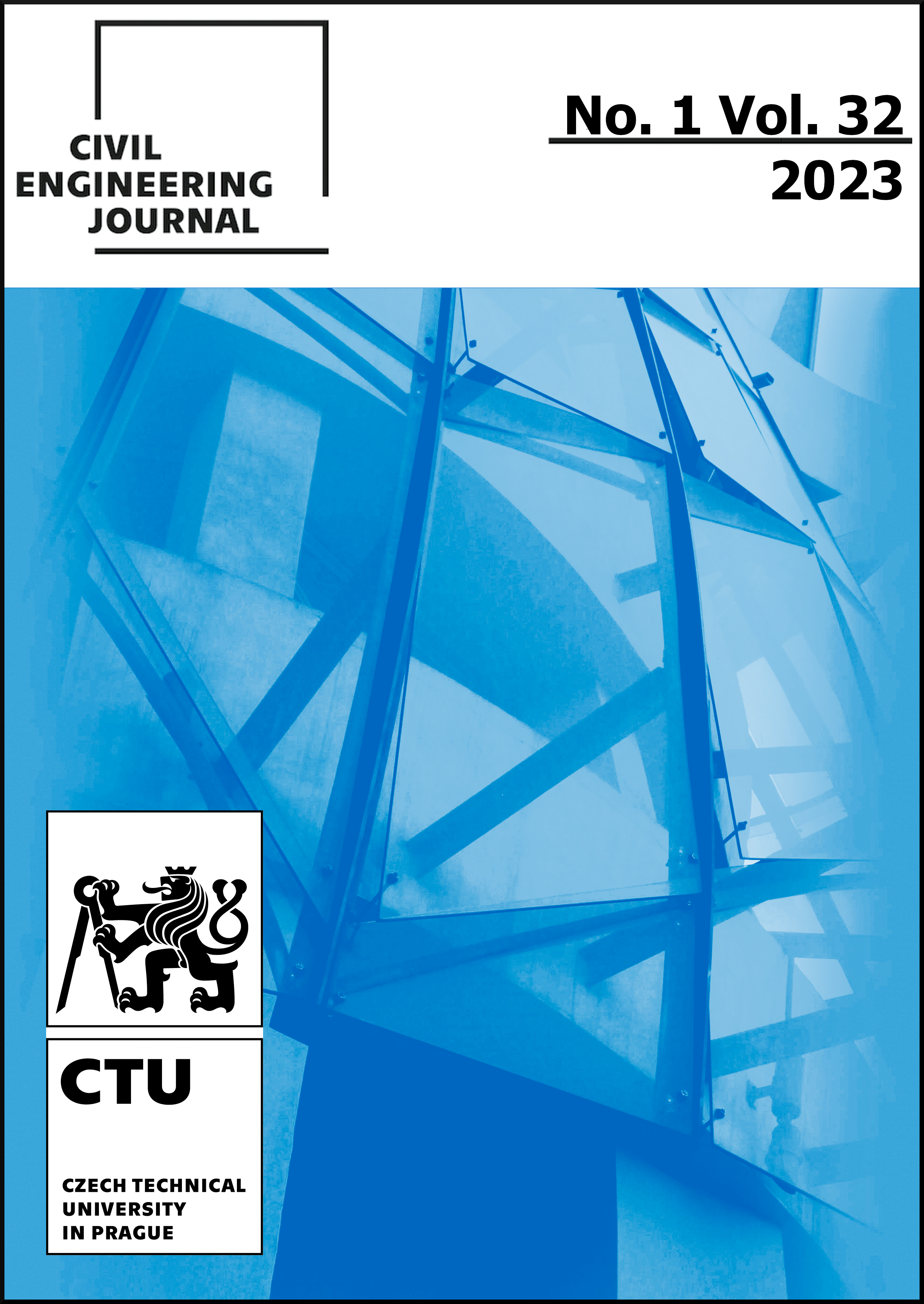Research on a safety evaluation system for railway-tunnel structures by fuzzy comprehensive evaluation theory
DOI:
https://doi.org/10.14311/CEJ.2023.01.0010Keywords:
Railway tunnels, Safety factor, Tensile range of vault, Safety evaluation, Fuzzy comprehensive evaluationAbstract
Long-term health detection of railway-tunnel is the development direction and trend of future railway tunnel research. Based on the actual engineering of a railway tunnel, this study developed a safety evaluation model for railway tunnel structures using a fuzzy comprehensive evaluation method and examined a health state evaluation method suitable for most railway tunnel structures. The results showed that the evaluation method comprehensively reflected the impact of various factors, which had strong practicality. The evaluation results were clear, accurate, and consistent with engineering practice. When using the safety factor index to study the stress of a railway tunnel structure, Midas/civil analysis showed that different levels of the surrounding rock structural vault in railway tunnels were in a tensile, control-bearing capacity state. When calculating safety factors, the range of a 60° central angle of a railway tunnel vault was calculated according to the tensile control-bearing capacity. Theoretical formulas of the range of the center angle φ0 of the vault tension zone were derived and then verified by experiments and numerical analysis.
Downloads
References
Li X.J., He F., Wang Y.B. et al., 2014. Tunnel Structure Safety Monitoring System Based on BOTDA Technology. Applied Mechanics and Materials, vol. 3368: 281-284.
Ni X., Goodwine B., 2020. Damage modeling and detection for a tree network using fractional-order calculus. Nonlinear Dynamics, vol. 101: 875-891.
Sun H., Liu S., Zhong R., Du L., 2020. Cross-Section Deformation Analysis and Visualization of Shield Tunnel Based on Mobile Tunnel Monitoring System. Sensors, vol. 20: 1006.
Judit G., Joan R.C., Sergi V., 2020. Structural Health Monitoring with Distributed Optical Fiber Sensors of tunnel lining affected by nearby construction activity. Automation in Construction, vol. 117.
Yang S., Zong L., Wang Y., 2011. Review on the research of highway bridges seismic damage assessment. Applied Mechanics and Materials, vol. 1446: 1224-1229.
Hou G.Y., Xie B.B., Hu T., 2017. Fiber sheath effect in tunneling monitoring based on BOTDR technology. Rock and Soil Mechanics, vol. 38: 2441-2447.
Lyu H., Shen S., Zhou A., 2022. Assessment of safety status of shield tunnelling using operational parameters with enhanced SPA. Tunnelling and Underground Space Technology incorporating Trenchless Technology Research, vol. 123.
Kazaras K., Kirytopoulos K., Rentizelas A., 2012. Introducing the STAMP method in road tunnel safety assessment. Safety Science, vol. 50: 1806-1817.
Ou G., Jiao Y., Zhang G., 2021. Collapse risk assessment of deep-buried tunnel during construction and its application. Tunnelling and Underground Space Technology incorporating Trenchless Technology Research, vol. 115.
Guo K., Zhang L., 2021. Multi-source information fusion for safety risk assessment in underground tunnels. Knowledge-Based Systems, vol. 227.
Zhou S., Xiang Q., Wang Y., 2014. The Evaluation Method for Tunnel Structure Health Condition Based on Asymmetric Proximity. Applied Mechanics and Materials, vol. 2014: 1721-1727.
Wang H., Noori M., Zhang J., 2016. A Wavelet-energy based damage identification method for steel bridges. Proceedings of the International Conference on Smart Infrastructure and Construction, vol. 2016.
Pan Q., Dias D., 2017. Safety factor assessment of a tunnel face reinforced by horizontal dowels. Engineering Structures, vol. 142: 56-66.
Alexakis H., Makris N., 2013. Minimum thickness of elliptical masonry arches. Acta Mechanica, vol. 224: 2977-2991.
Yuan W., Guo A., Li H., 2017. Seismic failure mode of coastal bridge piers considering the effects of orrosion-induced damage. Soil Dynamics & Earthquake Engineering, vol. 93: 135-146.
Liu X., Liu Y., Qu W., 2016. Internal force calculation and supporting parameters sensitivity analysis of side piles in the subway station excavated by Pile-Beam-Arch method. Tunnelling and Underground Space Technology incorporating Trenchless Technology Research, vol. 56: 186-201.
Zhong C., Yang Q., Liang J., 2021. Fuzzy comprehensive evaluation with AHP and entropy methods and health risk assessment of groundwater in Yinchuan Basin, northwest China. Environmental Research, vol. 204: 111956-111956.
Bai H., Wang N., 2010. Research on the selection of scale in AHP. IEEE, vol. 2010.
Zul I., Indrani S., Adi A.J., 2022. Analysing dimensions and indicators to design energy education framework in Malaysia using the analytic hierarchy process (AHP). Energy Reports, vol. 8: 1013-1024.
Hamidah M., Hasmadi I., 2022. Development of a protocol for Malaysian Important Plant Areas criterion weights using Multi-criteria Decision Making-Analytical Hierarchy Process (MCDM-AHP). Global Ecology and Conservation, vol. 34: e02033.
Li T., Yang B., 2010. Study on green logistics operation system of port based on AHP-fuzzy comprehensive evaluation. IEEE, vol. 2010.
Zhang J.W., Wang S., Huang H.X., 2014. Study on Classification and Regulation for Defects on Railway Tunnel. Applied Mechanics and Materials, vol. 3307: 1207-1211.
Wang Q., Yang J., Liang Y., 2020. Prediction of time-dependent behaviour of steel–recycled aggregate concrete (RAC) composite slabs via thermo-mechanical finite element modelling. Journal of Building Engineering, vol. 29: 101191.
Downloads
Published
Issue
Section
License
Copyright (c) 2023 Author

This work is licensed under a Creative Commons Attribution-NonCommercial 4.0 International License.
Authors who publish with this journal agree to the following terms:
- Authors retain copyright and grant the journal right of first publication with the work simultaneously licensed under a Creative Commons Attribution License that allows others to share the work with an acknowledgement of the work's authorship and initial publication in this journal.
- Authors are able to enter into separate, additional contractual arrangements for the non-exclusive distribution of the journal's published version of the work (e.g., post it to an institutional repository or publish it in a book), with an acknowledgement of its initial publication in this journal.
- Authors are permitted and encouraged to post their work online (e.g., in institutional repositories or on their website) prior to and during the submission process, as it can lead to productive exchanges, as well as earlier and greater citation of published work (See The Effect of Open Access).
How to Cite
Accepted 2023-03-20
Published 2023-04-30











